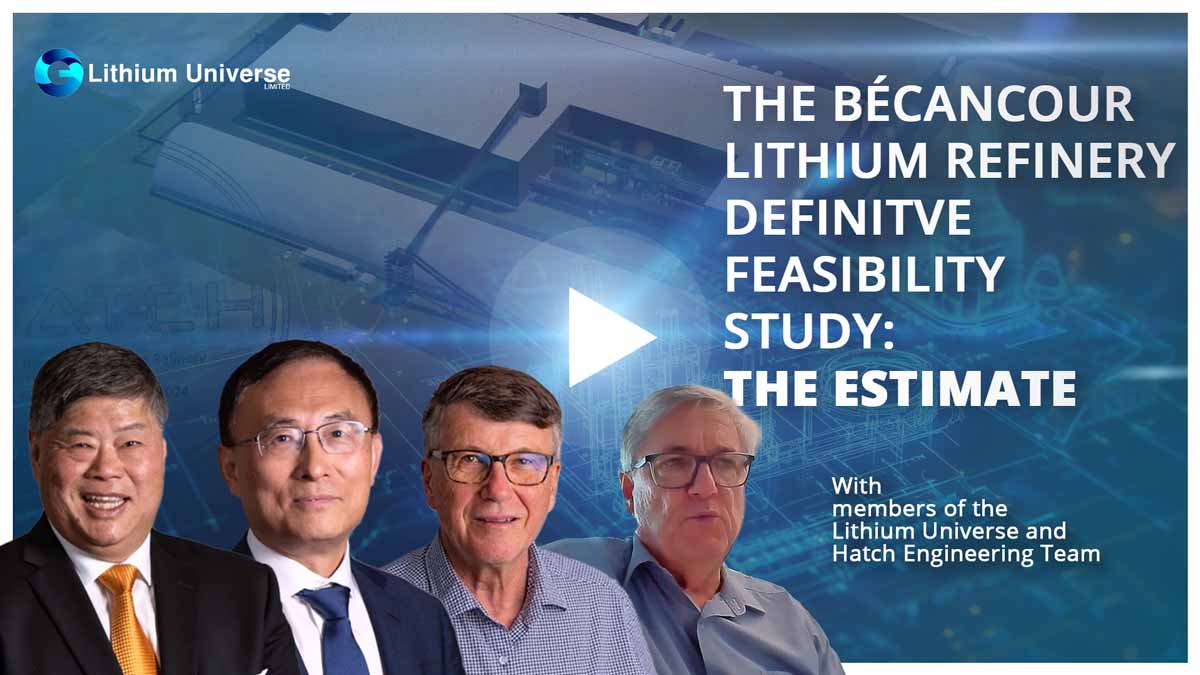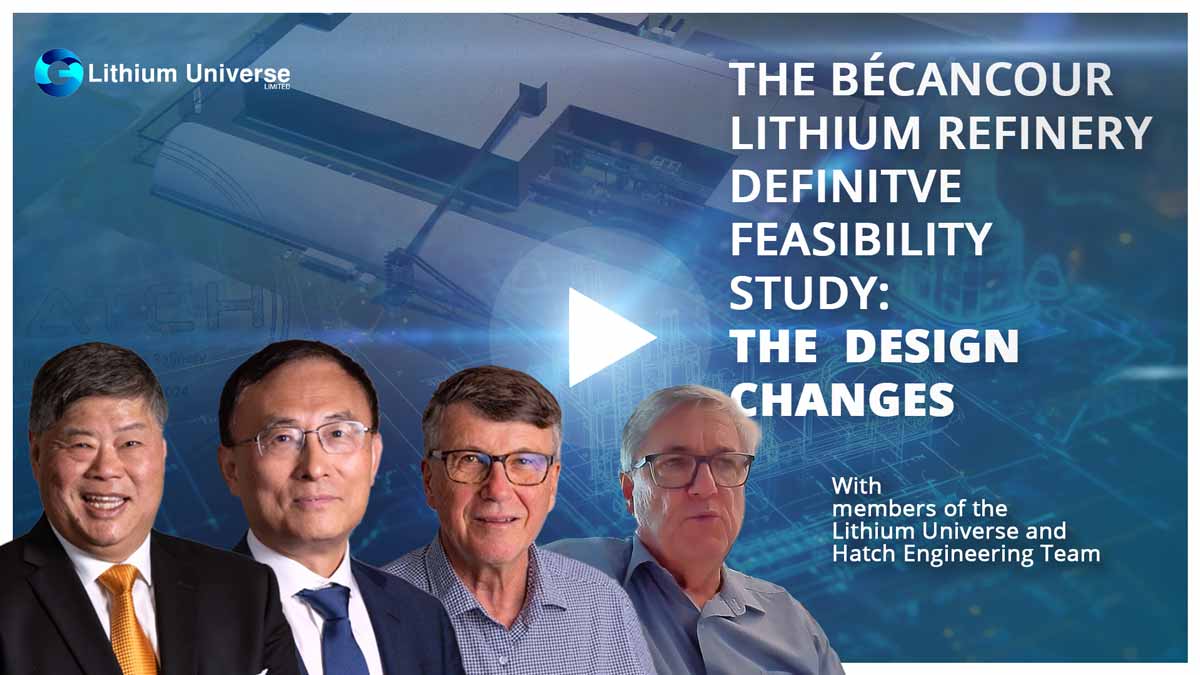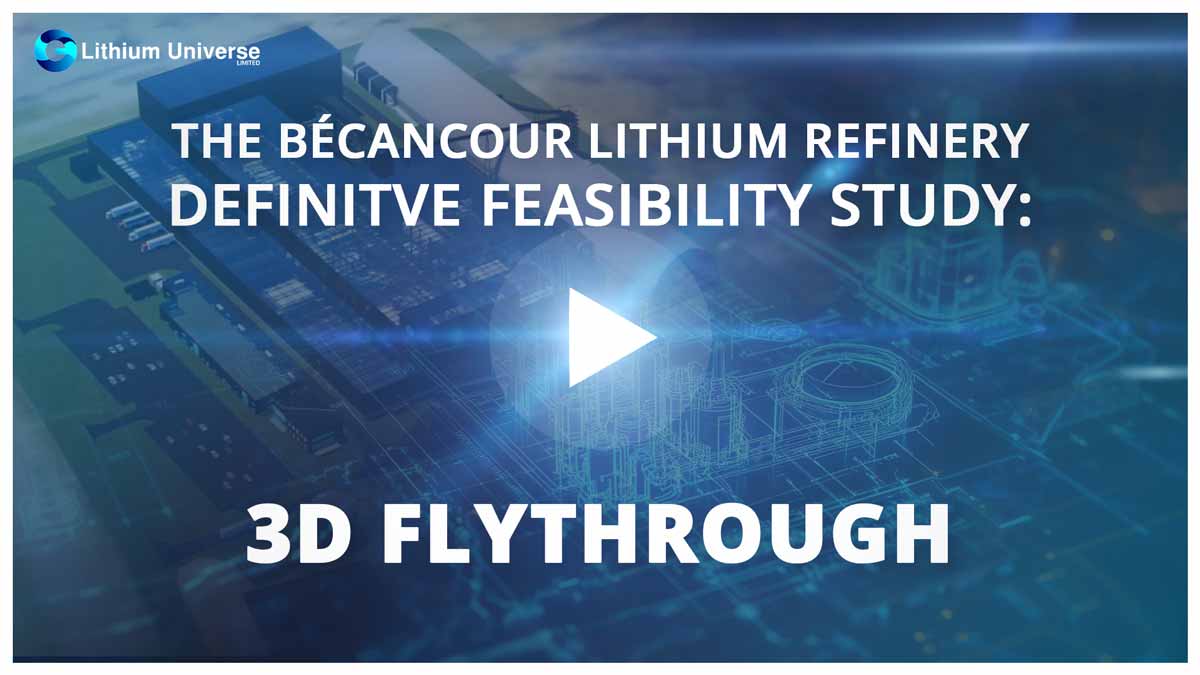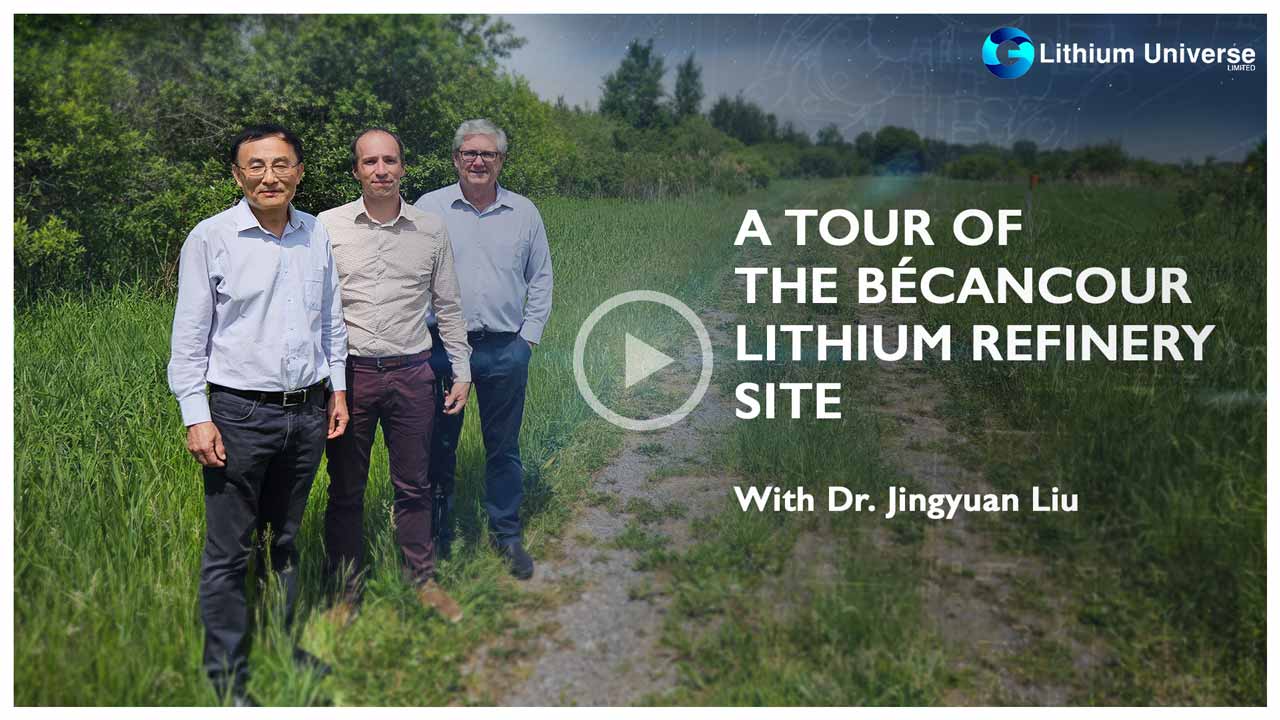THE BECANCOUR LITHIUM REFINERY:
DEFINITVE FEASIBILITY STUDY
HIGHLIGHTS
• Positive, robust Bécancour Refinery DFS even in low pricing environment
• LU7 Board has made Financial Investment Decision (FID) and proceeding to funding
• LU7 has a counter cyclical strategy – develop project, ready for price recovery
• Closing the Lithium Conversion Gap – growth in resource and end market projects
Lithium Universe (ASX: LU7) is pleased to announce the results of its Definitive Feasibility Study (DFS) for the Bécancour Lithium Carbonate Refinery in Québec, Canada. The Company previously released a Preliminary Feasibility Study in October 2024. The follow-up DFS confirms the viability of a strong lithium conversion project, even within a below-average pricing environment. The Company plans to build a reliable, low-risk lithium conversion refinery with an annual capacity of up to 18,270 tonnes, utilising proven expertise from the Jiangsu processing model. The facility will produce environmentally friendly, battery-grade lithium carbonate. The Company aims to establish a Canadian-based lithium chemicals business, purchasing spodumene feedstock from both domestic suppliers and international markets, including Brazil and Africa and producing a battery-grade lithium carbonate product. This aligns with the Company’s broader vision of contributing to the North Atlantic lithium supply chain and closing the Lithium Conversion Gap.
The project’s economics continue to be highly favourable, even with conservative price assumptions. The refinery is economically viable with a pre-tax Net Present Value (NPV) of approximately US$718 million, using an 8% discount rate, and a pre-tax Internal Rate of Return (IRR) of around 21.0%. The full rate payback period is estimated at 3.9 years. The financial model is built on cautious price forecasts of US$1,170 per tonne for spodumene concentrate (SC6) and US$20,970 per tonne for battery-grade lithium carbonate equivalent (LCE). LU7’s directors believe they have a reasonable basis for using the assumed price in the study of US$20,970 per tonne for battery-grade lithium carbonate. Key operational assumptions include 86% plant availability and 88% lithium recovery. At full production capacity, the project is expected to generate approximately US$383 million in annual revenue, with costs totalling around US$236 million, leading to an annual EBITDA of approximately US$148 million and a gross margin of in the region of 39%. Post-tax, the NPV at an 8% discount rate is estimated at approximately US$449 million. The capital cost for the project is estimated at US$549 million, which includes a contingency of US$51 million.
The capital cost has risen by 11% compared to the PFS, primarily driven by the inclusion of a Zero Liquid Discharge (ZLD) system (US$30 million) to enable the recycling and reuse of all process water on-site. Additional factors, such as escalation and updated pricing quotes, also contributed to this modest increase. The capital costs estimate is based on advanced design specifications from the Jiangsu Lithium Refinery model, ensuring robust financial planning and projection. These factors highlight the project’s strong financial viability, even under conservative pricing conditions.
WATCH: Members of the Lithium Universe (ASX: LU7) and Hatch Engineering discuss the key changes made in the DFS, the CAPEX estimate, and the project going forward. (15min)
The Financial Model
- Economically viable with excellent pre-tax NPV8% of approximately US$718M
- IRR (pre-tax) of approximately 21.0% and payback of 3.9 years based on;
- Price forecast of US$1,170/t SC6 and US$20,970/t for battery grade Li2CO3
- Current spot price is approx. US$775/t SC6 and US$10,680/t for battery grade LC
- Operating costs at around US$3,931/tonne;
- Capital cost estimate of US$549 million
- 11% increase from PFS mainly due to Zero Liquid Discharge (ZLD) system and escalation
- Expected annual revenue of approx US$383 million and EBITDA of around US$148 million
- Project break even at around US$740 /t (SC6) and around US$14,000 per tonne LC

WATCH: In this excerpt from the full chat members of the Lithium Universe and Hatch Engineering discuss the key factors involved in making a good CAPEX estimate. (5min)
“The strong NPV and returns for the project indicate an economically viable project and the Board has made the Financial Investment Decision (FID), and the project is now proceeding to the funding stage. An equity and debt adviser will be engaged to lead the funding outreach program, aimed at securing strategic partners at the project level to support project financing. Initial discussions with various banks and debt providers have been encouraging.
The Company will continue discussions with interested OEMs with spodumene offtake supply seeking conversion outside of China. We are confident that the Bécancour lithium refinery, with an annual capacity of 18,270 tonnes, will emerge as a leader in producing green, battery-grade lithium carbonate. We recognized that bridging the lithium conversion gap in North America, leveraging our accumulated lithium expertise and the proven technology from Jiangsu, is a clear strategy.
Our counter-cyclical strategy is centered on advancing projects during market downturns, allowing us to strategically position ourselves for growth as the market rebounds. We are dedicated to funding and constructing a proven, low-risk lithium conversion refinery in Québec, marking the first step toward establishing Québec as the lithium conversion hub for the Transatlantic region.”
- Iggy Tan
Lithium Universe Chairman
The Design
• LU7 offers a solution to worldwide lithium conversion failures and startup problems
• Using proven Jiangsu Refinery operating technology and lithium industry experience
•Producing up to 18,270 tonnes/year of green battery-grade lithium carbonate
•Smaller off-the-shelf style plant rather than large difficult-to-operate facilities
• Initial focus on lithium carbonate production – feed for LFP batteries
• Assumptions based on real operating data and experience – not new aspirant

WATCH: In this excerpt from the full chat members embers of the Lithium Universe and Hatch Engineering discuss the main changes made to the design in the DFS. (5min)
The Model

WATCH: A flythrough of the 3D model of the Becancour Lithium Refinery that was used in the DFS. (1min)
The Location
• Québec ideal trans-Atlantic lithium conversion centre, comparable to China
• Feedstock from Canada, Brazil and Africa – end market North America
• Critical cost benefits – cheap green power, transport mine/end market savings, US/Canada tariffs
• 95% GHG emission reduction with Hydro Québec’s green energy

WATCH: LU7 Director Dr. Jingyuan Liu take a tour of the proposed lithium Refinery site at Becancour. (2min)
Have a question for the Lithium Universe Teamabout the Definitive Feasibility Study or Becancour Lithium Carbonate Refinery?
We encourage you to jump onto our Investor Hub and ask us directly.
Next Steps
• Offtake discussions with interested OEMs underway
• LU7 to embark on the funding stage of the project

WATCH: In this excerpt from the full chat members embers of the Lithium Universe and Hatch Engineering discuss the key risks going forward in the DFS. (5min)
The Company will actively engage with financial institutions and government agencies to secure project financing by presenting the findings from the Definitive Feasibility Study (DFS). Concurrently, LU7 will advance environmental assessments and the permitting process, ensuring regulatory compliance and addressing potential issues proactively. The due diligence process will be coordinated with federal and provincial authorities to obtain necessary approvals.
Discussions with strategic partners regarding offtake agreements and feedstock supply will continue to secure stable supply chains. Additionally, LU7 will conduct a comprehensive impact analysis in consultation with the local First Nation group to incorporate community feedback and promote sustainable development. These steps are essential to progressing the Bécancour project with thorough planning, strong financial backing, and robust stakeholder engagement.

